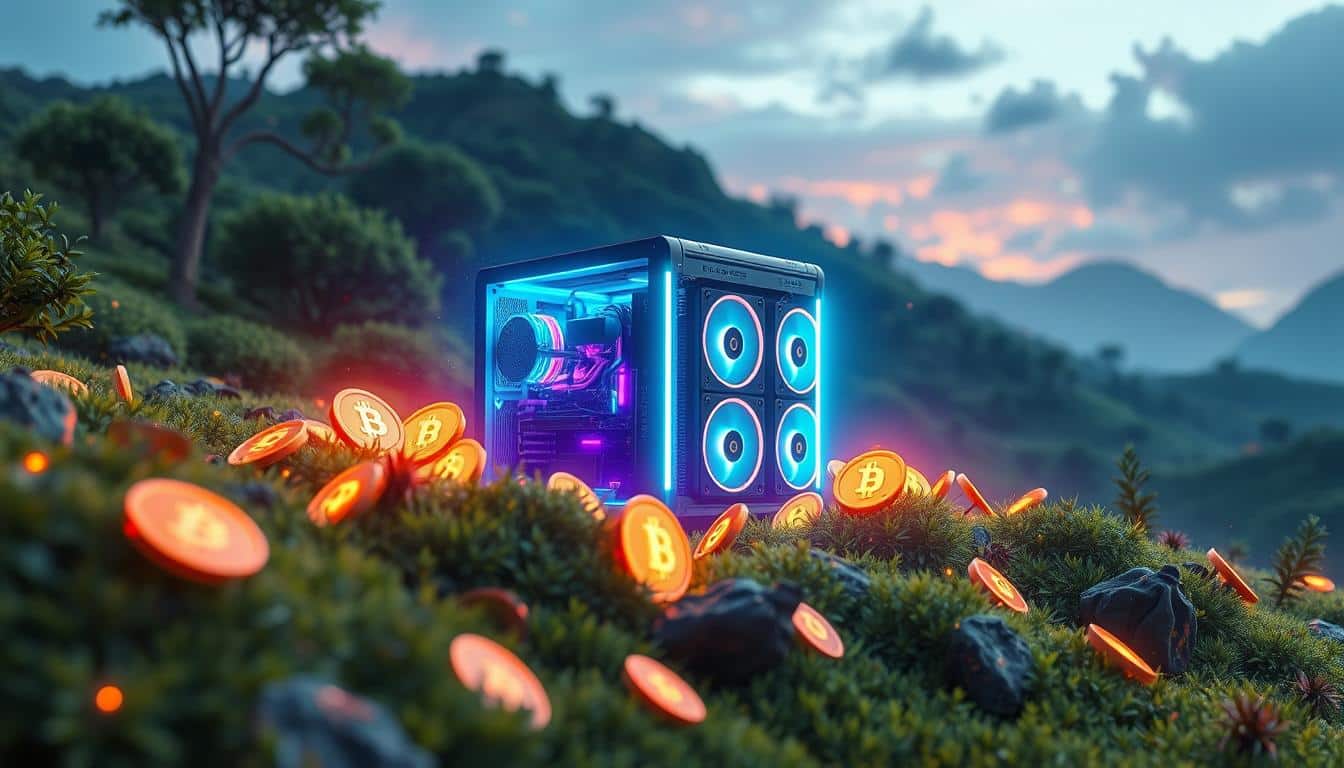Discover the Easiest Crypto to Mine Today
Did you know Ravencoin (RVN) rewards miners with 2500 RVN/block and can bring in about $871 each month? It’s perfect for beginners using CPU or GPU setups2. RVN is easy to start with due to its low hardware needs and being ASIC-resistant, making it a top choice for new miners.
Finding easy-to-mine crypto can lead to a smooth, profitable start in the digital world. While Bitcoin mining now needs advanced equipment, other cryptocurrencies are still within reach for basic setups. This guide introduces you to simple mining options that are quickly set up and can earn you money passively.
Key Takeaways
- Cryptocurrency mining allows for passive income and supports decentralized networks.
- Factors such as hardware and electricity costs must be considered before mining.
- Cryptocurrencies like Monero, Ravencoin, and Zcash are beginner-friendly.
- Each crypto has its unique hardware requirements, making some easier to mine than others.
- Finding the right mining software is crucial for optimizing your setup.
What is Cryptocurrency Mining?
Cryptocurrency mining is how new digital coins come to life. It’s also how transactions get checked on a blockchain network. Miners use a lot of computer power to crack complex puzzles. When they crack a puzzle, they get cryptocurrency as a prize. For example, miners get 3.125 Bitcoin for each puzzle they solve, worth about $196,875 as of April 20243. This activity keeps the blockchain network safe and accurate4.
Definition and Process
Mining is about solving puzzles to check transactions and add them to a blockchain. Every successful check makes the network safer. Miners get rewards for their work. This needs special computers and software. People often use powerful graphics cards or special circuits to mine efficiently4.
The energy used for Bitcoin mining is huge. It’s around 120 TWh per year. This is more than the entire energy use of Argentina5.
Types of Crypto Mining (CPU, GPU, ASIC)
There are three main ways to mine cryptocurrency:
- CPU Mining: This method uses the computer’s main processor. It’s not very efficient. It uses a lot of energy and power, so it’s not great for mining most cryptos5.
- GPU Mining: This uses graphic cards. They’re better at the complex maths needed for mining. GPUs are especially good for mining different kinds of coins, making them quite popular5.
- ASIC Mining: This uses devices made just for mining. They’re the most efficient option and are often used for big mining setups. These devices are great at solving puzzles fast and don’t use as much energy4.
Mining is not just for creating coins. It also checks the transactions on the blockchain network. This requires a lot of computer power. Using GPUs or ASICs4 requires lots of electricity. Mining Bitcoin alone uses 176 terawatt-hours each year. That’s more power than countries like the Netherlands or the Philippines use3
Why Mine Cryptocurrency?
Mining cryptocurrency is a great way to earn passive income. It helps decentralized networks to grow. Miners get rewards for their computational work.
Potential for Passive Income
Miners earn rewards that can be quite large. For example, mining a Bitcoin block might get you 3.125 Bitcoin. That’s about $196,875 as of April 20243. The rewards depend on how much work you do4. If you’re looking for ways to make money quickly, check out short-term cryptocurrency investments.
Support Decentralized Networks
Mining is essential for keeping decentralized networks safe. It validates transactions and adds new blocks. Mining needs special computers and a lot of energy6.
Miners use ASICs and GPUs to mine6. By mining, you play a part in spreading out power. This lessens the chance of any one party having too much control.
Factors to Consider Before Mining
Before you start cryptocurrency mining, it’s vital to look at key factors. These can affect how much you spend and earn, so you don’t face surprises. By understanding these elements, you’ll be better prepared.
Hardware Costs
Buying the right hardware is a big cost in crypto mining. For example, the Bitmain Bitcoin Miner S19 XP costs about $4,653. It has a hash rate of 141 terahashes per second (TH/s)7. On the other hand, the Bitcoin Miner S21 costs around $7,000 and works at 200 TH/s7.
Advanced Micro Devices (AMD) sees a lot of demand for GPUs. The RTX 4090 graphic card is a favorite, priced at $1,700. It hashes between 250 mega hashes per second (MH/s) and 12.7 giga hashes per second (GH/s)78.
Electricity Costs
Electricity is a big ongoing cost that impacts how profitable mining is. A typical ASIC miner needs about 72 terawatts of power to mine one bitcoin in nearly ten minutes8. You need to know your local energy costs and how efficient your mining gear is. This helps you manage your expenses well.
Joining mining pools can spread out electricity costs. It might also boost your chances of getting mining rewards. This balance is key for profit over time.
Top Beginner-Friendly Cryptocurrencies to Mine
If you’re new to mining, it’s key to pick a cryptocurrency that’s easy to mine. Monero (XMR), Ravencoin (RVN), and Zcash (ZEC) are top picks. They offer simple mining and low entry barriers for starters.
Monero (XMR) is great because it fights against ASIC devices. This means you won’t need fancy machines to mine. It has a market cap of $2.5 billion. Average daily trades go from $40 million to $100 million. So, it’s a solid choice for easy mining opportunities9.
Ravencoin (RVN) is another great pick, with a market cap of $350 million. It has an average daily trade of $50 million. This ensures it stays profitable and beginner-friendly9. Zcash (ZEC) is also a good choice. It values privacy and has a market cap of $470 million. Daily trades range between $40 million and $80 million, striking a nice balance9.
Here is a comparison of these top beginner-friendly cryptocurrencies:
| Cryptocurrency | Market Cap | Average Daily Volume |
|---|---|---|
| Monero (XMR) | $2.5 billion | $40 million – $100 million |
| Ravencoin (RVN) | $350 million | $50 million |
| Zcash (ZEC) | $470 million | $40 million – $80 million |
These cryptocurrencies are great for starters. They offer easy mining and help newcomers join the mining world smoothly. They’re perfect for anyone wanting to dip their toes in cryptocurrency mining.
Hardware Requirements for Easy Mining
Choosing the right mining hardware is key for the best performance in cryptocurrency mining. You need the right tools, whether it’s for CPU rigs, GPU setups, or ASIC solutions. This will help ensure your mining is effective.
CPU Mining
Beginners often start with CPU mining. They prefer CPUs like AMD’s Ryzen 7 and Intel’s Core i710. With these, you can mine cryptocurrencies like Monero on normal computers. Yet, CPU mining’s hash rates aren’t as high as those from GPU or ASIC mining.
GPU Mining
GPU mining is known for its good balance between cost and performance. Brands like NVIDIA and AMD lead here, with favorites being the NVIDIA GeForce RTX 30 series and AMD Radeon RX 6000 series10. A good GPU mining setup needs dedicated GPUs, strong motherboards, and reliable power supplies11.
Some top motherboard choices are ASUS Prime Z390-P and Gigabyte B550 Aorus Pro10. To keep things cool and running well, you’ll also need fans, CPU coolers, and GPU cooling systems10.
ASIC Mining
ASIC mining is top-notch for coins like Bitcoin12. These devices are specialized to boost hash rates while using less power11. Though ASIC miners might cost between $1,000 and $3,000, they’re very efficient12. Having strong cooling and a steady internet connection is vital11.
For power supply needs, brands like Corsair, EVGA, and Seasonic are reliable. They help ASIC rigs stay durable and efficient10.
Monero (XMR) – Privacy and Accessibility
Monero (XMR) is unique for its strong privacy and ease of use, starting in 2014. It was made to offer safe, unseen money movements13. It hides transaction details with complex code methods like ring signatures and stealth addresses1314. This makes sure users keep their actions private. Because of this, Monero is a favorite among those wanting hidden financial dealings.
ASIC-Resistance
Monero uses the CryptoNightV7 algorithm to avoid ASIC control. This lets more people mine with common computers, keeping the process fair for all13. The switch to RandomX algorithm kept this fairness by supporting mining with everyday hardware14.
Easy Mining with CPU/GPU
Monero works well for mining at home because it supports CPU/GPU setups. You don’t need fancy equipment to start mining Monero13. Just a computer, some mining software, and internet access are enough to get going14. Joining a group like P2Pool can help secure steadier rewards for miners14.
Mining Rewards
Monero’s mining offers good returns, enticing for those new to crypto mining. The reward stands at 0.6 XMR per block, drawing more participants14. Its lower mining difficulty also makes it appealing to those seeking profitable privacy coin options.
Overall, Monero’s focus on privacy and resistance to ASICs positions it well for CPU and GPU miners. It offers a balanced mix of profit and simplicity in gaining Monero mining rewards.
Ravencoin (RVN) – Versatility and Ease
Ravencoin is a versatile and easy-to-mine cryptocurrency. It offers special features like token issuance.
Token Issuance
Ravencoin lets users issue tokens within its blockchain ecosystem. Creating a unique asset on Ravencoin’s blockchain only takes 5 RVN. This makes it accessible to many users15. From November 2018 to January 2021, over 25,000 tokenized assets were created on the Ravencoin chain by using RVN15. This feature adds value to the Ravencoin mining process by giving miners extra incentives.
ASIC-Resistance
Ravencoin uses the KAWPOW algorithm to stay ASIC-resistant. This algorithm fits well with graph card architecture, which makes mining Ravencoin easy for all miners16. KAWPOW brings new features that make it fair for both ASIC and GPU miners. It uses a bigger mix state, a random computing sequence, and needs more DRAM16. These innovations protect the network from threats.
CPU and GPU Mining
Ravencoin’s design allows for mining with CPUs and GPUs. Miners have various software options like TeamRedMiner (2% fee for AMD), T-Rex Miner (1% fee for Nvidia), and others16. This opens up mining to more people, enhancing the network’s security and decentralization. Joining a mining pool can also boost earnings for small miners through the Pay Per Share system15.
| Criteria | Details |
|---|---|
| Current RVN Price | $0.01625 |
| Circulating Supply | 14.25 billion |
| Total Supply | 21 billion |
| Block Reward | 2,500 RVN |
Currently, RVN is priced at $0.01625. It has a circulating supply of 14.25 billion from a total of 21 billion17. This makes Ravencoin a good choice for those interested in mining.
Zcash (ZEC) – Privacy and Profitability
Zcash (ZEC) is famous for its privacy features. It could be a profitable option for mining. It was created in 2016 by Zooko Wilcox-O’Hearn. Zcash uses a special technology called zk-SNARK to improve privacy and security18. Users can pick from transparent transactions, like those in Bitcoin, or go for shielded ones to keep things private18.
Zcash is mined using the Equihash algorithm. This algorithm is designed to prevent ASIC devices from taking over, making it easier for GPU miners. The global hashrate for Zcash stands at 4.19 PH/s, showing its strong network19. However, making a profit from mining Zcash can be hard. For example, the profit margin is currently at -174.07%19.
The coin has a steady block reward of 2.5000 ZEC every 1.25 minutes. This gives GPU miners the chance to earn significant rewards1918. Daily mining rewards for Zcash are $80,229.21, with a yield of 2,880.00 ZEC19. But, it’s essential to look at the total returns. For instance:
| Time Frame | Estimated Rewards (ZEC) | Profit/Loss ($) |
|---|---|---|
| Hourly | 0.00204685 | ($0.0983) |
| Daily | 0.04912432 | ($2.36) |
| Weekly | 0.34387024 | ($16.54) |
| Monthly | 1.4741456 | ($70.88) |
| Annually | 17.6897472 | ($862.38) |
With these points in mind, Zcash still stands strong among profitable mining coins. Though its initial value was over $5,000, which was more than 6 Bitcoins, its price can change a lot18. Yet, miners are drawn to Zcash for its top-notch privacy features and the Equihash algorithm’s resistance to ASIC, giving GPU miners a good shot at rewards1918.
Vertcoin (VTC) – The Open Source Option
Vertcoin (VTC) is a top open-source cryptocurrency that focuses on mining for the community. It ensures a fair game by being ASIC-resistant. This means you can mine using just your computer’s CPU or GPU.
Community-Driven
Being led by its community, Vertcoin shows its dedication to staying open and decentralized. It started in 2014 without an ICO, airdrop, or pre-mine. With 9,400 Discord members, 62k Twitter followers, and 33k subreddit users20, its community is central to its growth and success.
ASIC-Resistance
Keeping ASIC-resistance is core to Vertcoin’s identity. It has successfully gone through three hard forks. This has kept mining decentralized by moving through various algorithms like Scrypt Adaptive N and Lyra2RE versions20. To combat the rise of FPGA hardware, the team, led by MIT’s James Lovejoy, developed Verthash. This algorithm keeps the mining landscape fair and secure21.
CPU/GPU Mining Capabilities
Vertcoin stands out for its home miner friendliness, showcased by the VTC One-Click Miner (OCM)21. This tool makes mining easy for folks without much tech know-how, promoting a truly decentralized network. Vertcoin boasts a 683.21% ROI, a market cap of $4,263,694, and 68,039,110 VTC in circulation22.
The following table provides a quick overview of Vertcoin’s market statistics:
| Statistic | Value |
|---|---|
| Current Price | $0.06618 |
| Market Cap | $4,263,694 |
| 30-Day Low | $0.04401 |
| 30-Day High | $0.06961 |
| All-Time High | $10.00 (Dec 6, 2017) |
| All-Time Low | $0.005343 (May 6, 2015) |
| ROI | 683.21% |
| Circulating Supply | 68,039,110 VTC |
| Projected 2024 Price | $0.094868 |
| Projected 2025 Price Range | $0.06392 to $1.568 |
Vertcoin shines because of its active community and solid technology. It’s a major player in the world of open-source crypto and community mining2220.
Ethereum Classic (ETC) – Stability and Rewards
Ethereum Classic (ETC) is a top pick for miners because of its steady nature and mining perks. It stuck with the original blockchain after Ethereum split. It uses a Proof of Work (PoW) system, much like Bitcoin23. This method makes it strong and reliable.
Miners on the ETC blockchain work with GPUs or ASIC machines for best results. Mining a block successfully gives miners 2.5 ETC. This is a good deal for those mining Ethereum Classic. Unlike Ethereum’s switch to PoS, ETC remains a solid choice for the future.
In August 2023, Ethereum (ETH) has a much higher hash rate than Ethereum Classic. This means mining ETC is less difficult24. Ethereum Classic also uses less energy. This makes it a better option for mining in the long run24.
Ethereum Classic stands strong even when the market is down. Its emphasis on safety and unchangeability keeps it stable. Right now, mining one block takes a huge effort of 1,630,000,000,000,000 hashes every 13 seconds23.
Despite tougher competition, ETH’s move to PoS might turn miners towards ETC. Those who like the PoW method see it as stable with steady rewards. This change could affect how you invest in mining. For tips on making money with crypto, look at sure bets in the crypto market.
Ethereum Classic offers a rewarding mining scene with less rivalry than Ethereum. The rewards for mining on the ETC blockchain are still appealing. This provides a smart way to keep profitability and energy use in check in cryptocurrency mining’s fast-paced world.
Dash (DASH) – Fast Transactions
Dash was launched in 2014 and became a top choice for those into cryptocurrency quickly25. Its block time is only 2.5 minutes, much faster than Bitcoin’s 10 minutes. This speed has made Dash mining a good option for quick transactions and rewards26. Dash uses the X11 algorithm, making it mineable with ASIC and GPU tech. This leads to a strong mining community26.
In Dash mining, the rewards have a unique split. Miners and Masternodes each get 45% of the block rewards27. The last 10% goes to the Dash treasury. This setup not only rewards miners but also secures the network with Masternodes, which need 1000 DASH as collateral25.
Dash offers great mining advantages thanks to its fast blockchain and reward system. For example, a Bitmain Antminer D3 has a 17 GH/s hash rate, showing Dash mining can be very efficient27. Joining a Dash mining pool can also help increase reward chances by pooling resources with others26.
Dash uses a two-tier network of miners and Masternodes, splitting rewards evenly26. This setup boosts both security and efficiency. Plus, with over 40,000 users in Venezuela, Dash’s real-world use is clear25.
Learn more about Dash’s benefits and how it works by checking out this detailed article on Dash cryptocurrency25.
Dogecoin (DOGE) – Popular and Profitable
Dogecoin (DOGE) is a big hit with miners for a few reasons. Its strong community support and big mining rewards stand out. Public figures often give it a thumbs up, adding to its popularity. This strong backing makes more people want to mine Dogecoin.
Massive Community Support
The Dogecoin community is full of energy and always takes part actively. This keeps the network exciting and growing. Miners join forces in pools like Antpool, ViaBTC, and F2Pool for better earnings. Mining in a pool improves profits and makes the community tighter. Plus, mining Dogecoin alongside Litecoin means miners might get extra rewards28.
Mining Rewards
Another reason Dogecoin is so appealing is its big rewards for mining. Each block mined gives out 10,000 DOGE. This can add up to 14,400,000.00 DOGE a day. With today’s market, that means about $5,276.62 a year in mining revenue with good equipment and efficiency29. Different ASIC miners offer choices for how you want to mine, based on power and hash rate30.
If you’re thinking of starting with Dogecoin mining, check out guides on setup, pooling, and mining tips. You’ll find all the info you need in this detailed guide30.
The Easiest Crypto to Mine
Looking for the easiest crypto to mine means checking out a few key things. Things like the type of computer gear you have, how the coin rewards miners, and what makes the coin special. Monero (XMR) is one top pick because you can mine it with just regular computers or fancy gaming setups. It works at a speed of 54 KH/s and creates a new block every 2 minutes, rewarding miners with 0.65 XMR319. Thanks to its tech-friendly nature and a market value of $2.5 billion, it’s a hit among beginners9.
Ravencoin (RVN) is another good choice for mining, especially with powerful gaming computers like the Nvidia GTX 1080 Ti. It offers a big reward of 5,000 RVN3231 per block. With a network speed of 6.43 TH/s and blocks that take just 1 minute to mine, it’s more approachable than many cryptocurrencies31. Also, its market value of $350 million shows it has solid backing9.
If you’re against the big mining factories, Vertcoin (VTC) might be up your alley. It’s built to resist control by these big players and welcomes miners using both regular and gaming computers. Its network zips along at 2.36 GH/s31. Mining a block gives you 12.5 VTC and takes about 2.5 minutes31. Even though it’s smaller, with a market value of $3.6 million, it’s still a preferred choice for easy mining9.
Mining crypto can pay off but remember to think about electricity costs and how much coin prices jump around. High electric bills can eat into your mining earnings32. Big policy shifts, like China’s mining ban, can really shake things up32. It’s wise to weigh these factors when picking the best mining options.
| Cryptocurrency | Hashrate | Block Time | Block Reward | Market Cap |
|---|---|---|---|---|
| Monero (XMR) | 54 KH/s | 2 minutes | 0.65 XMR | $2.5B |
| Ravencoin (RVN) | 6.43 TH/s | 1 minute | 5,000 RVN | $350M |
| Vertcoin (VTC) | 2.36 GH/s | 2.5 minutes | 12.5 VTC | $3.6M |
How to Choose the Right Mining Software
Finding the right mining software is key to getting good results. Whether your gear uses a CPU or GPU, you need software to connect it to the blockchain. Picking the right one can really help your mining work well and make you more money. It’s important to know what software works best with your hardware.
Mining Software for CPUs
If you’re mining with a CPU, you want software that’s light but still does a lot. XMRig and CPUminer are top picks for lots of miners. These programs get the most out of CPUs without pushing them too hard. Make sure the software matches the crypto you’re mining to get the best results and more rewards.
Mining Software for GPUs
With GPU mining, you need software that can use your graphics card’s full power. CGMiner, EasyMiner, and BFGMiner are favorites because they’re powerful and easy to use. GPUs can mine crypto faster and better than CPUs, which could mean more money for you. Plus, advanced tools like Foreman can cut your power use by up to 97.2%33. Make sure the GPU mining software fits the crypto you want and supports your GPU model well.
Picking the right software for your CPU or GPU is crucial for great mining results. Whether you choose simple programs or advanced tools, the right software makes your mining operation a success.






